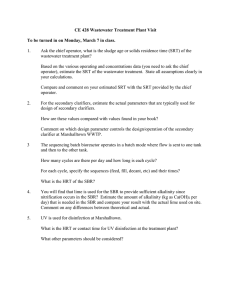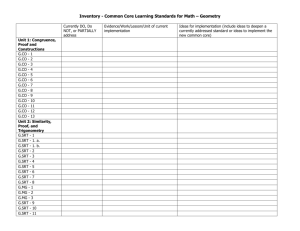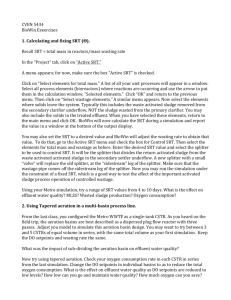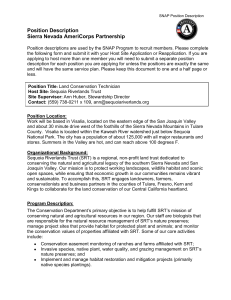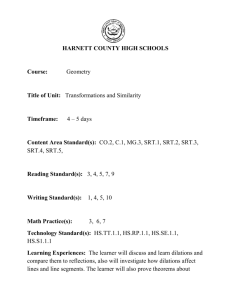Generation and Characterization of a Recombinant Human CCR5-specific Antibody
advertisement
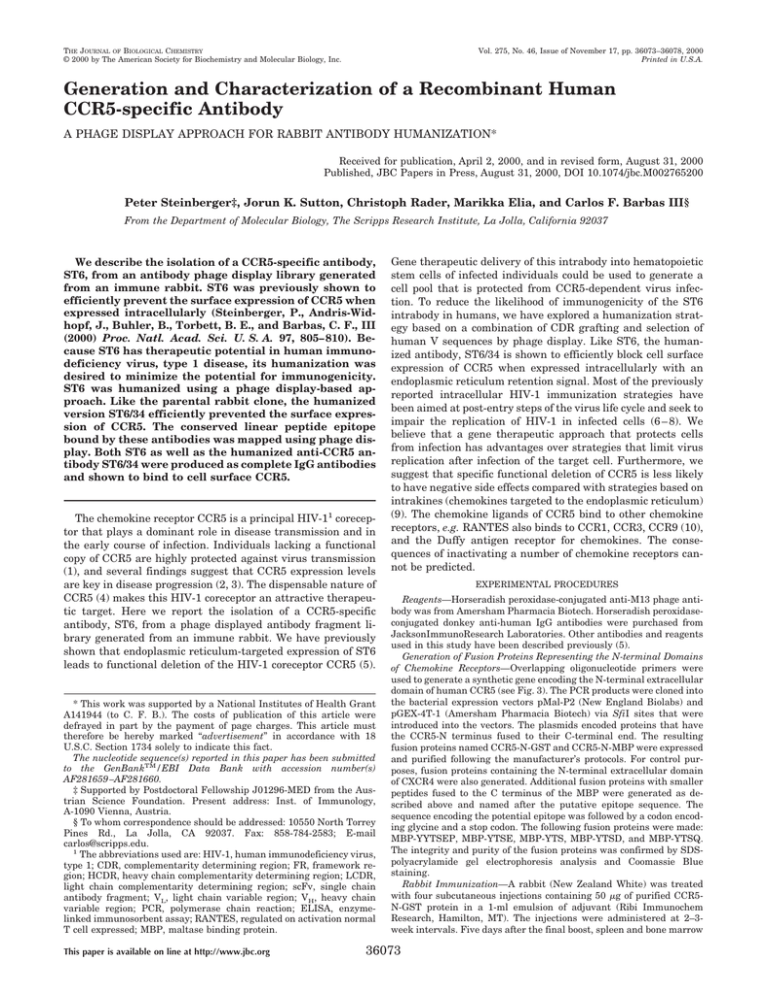
THE JOURNAL OF BIOLOGICAL CHEMISTRY © 2000 by The American Society for Biochemistry and Molecular Biology, Inc. Vol. 275, No. 46, Issue of November 17, pp. 36073–36078, 2000 Printed in U.S.A. Generation and Characterization of a Recombinant Human CCR5-specific Antibody A PHAGE DISPLAY APPROACH FOR RABBIT ANTIBODY HUMANIZATION* Received for publication, April 2, 2000, and in revised form, August 31, 2000 Published, JBC Papers in Press, August 31, 2000, DOI 10.1074/jbc.M002765200 Peter Steinberger‡, Jorun K. Sutton, Christoph Rader, Marikka Elia, and Carlos F. Barbas III§ From the Department of Molecular Biology, The Scripps Research Institute, La Jolla, California 92037 We describe the isolation of a CCR5-specific antibody, ST6, from an antibody phage display library generated from an immune rabbit. ST6 was previously shown to efficiently prevent the surface expression of CCR5 when expressed intracellularly (Steinberger, P., Andris-Widhopf, J., Buhler, B., Torbett, B. E., and Barbas, C. F., III (2000) Proc. Natl. Acad. Sci. U. S. A. 97, 805– 810). Because ST6 has therapeutic potential in human immunodeficiency virus, type 1 disease, its humanization was desired to minimize the potential for immunogenicity. ST6 was humanized using a phage display-based approach. Like the parental rabbit clone, the humanized version ST6/34 efficiently prevented the surface expression of CCR5. The conserved linear peptide epitope bound by these antibodies was mapped using phage display. Both ST6 as well as the humanized anti-CCR5 antibody ST6/34 were produced as complete IgG antibodies and shown to bind to cell surface CCR5. The chemokine receptor CCR5 is a principal HIV-11 coreceptor that plays a dominant role in disease transmission and in the early course of infection. Individuals lacking a functional copy of CCR5 are highly protected against virus transmission (1), and several findings suggest that CCR5 expression levels are key in disease progression (2, 3). The dispensable nature of CCR5 (4) makes this HIV-1 coreceptor an attractive therapeutic target. Here we report the isolation of a CCR5-specific antibody, ST6, from a phage displayed antibody fragment library generated from an immune rabbit. We have previously shown that endoplasmic reticulum-targeted expression of ST6 leads to functional deletion of the HIV-1 coreceptor CCR5 (5). * This work was supported by a National Institutes of Health Grant A141944 (to C. F. B.). The costs of publication of this article were defrayed in part by the payment of page charges. This article must therefore be hereby marked “advertisement” in accordance with 18 U.S.C. Section 1734 solely to indicate this fact. The nucleotide sequence(s) reported in this paper has been submitted to the GenBankTM/EBI Data Bank with accession number(s) AF281659 –AF281660. ‡ Supported by Postdoctoral Fellowship J01296-MED from the Austrian Science Foundation. Present address: Inst. of Immunology, A-1090 Vienna, Austria. § To whom correspondence should be addressed: 10550 North Torrey Pines Rd., La Jolla, CA 92037. Fax: 858-784-2583; E-mail carlos@scripps.edu. 1 The abbreviations used are: HIV-1, human immunodeficiency virus, type 1; CDR, complementarity determining region; FR, framework region; HCDR, heavy chain complementarity determining region; LCDR, light chain complementarity determining region; scFv, single chain antibody fragment; VL, light chain variable region; VH, heavy chain variable region; PCR, polymerase chain reaction; ELISA, enzymelinked immunosorbent assay; RANTES, regulated on activation normal T cell expressed; MBP, maltase binding protein. This paper is available on line at http://www.jbc.org Gene therapeutic delivery of this intrabody into hematopoietic stem cells of infected individuals could be used to generate a cell pool that is protected from CCR5-dependent virus infection. To reduce the likelihood of immunogenicity of the ST6 intrabody in humans, we have explored a humanization strategy based on a combination of CDR grafting and selection of human V sequences by phage display. Like ST6, the humanized antibody, ST6/34 is shown to efficiently block cell surface expression of CCR5 when expressed intracellularly with an endoplasmic reticulum retention signal. Most of the previously reported intracellular HIV-1 immunization strategies have been aimed at post-entry steps of the virus life cycle and seek to impair the replication of HIV-1 in infected cells (6 – 8). We believe that a gene therapeutic approach that protects cells from infection has advantages over strategies that limit virus replication after infection of the target cell. Furthermore, we suggest that specific functional deletion of CCR5 is less likely to have negative side effects compared with strategies based on intrakines (chemokines targeted to the endoplasmic reticulum) (9). The chemokine ligands of CCR5 bind to other chemokine receptors, e.g. RANTES also binds to CCR1, CCR3, CCR9 (10), and the Duffy antigen receptor for chemokines. The consequences of inactivating a number of chemokine receptors cannot be predicted. EXPERIMENTAL PROCEDURES Reagents—Horseradish peroxidase-conjugated anti-M13 phage antibody was from Amersham Pharmacia Biotech. Horseradish peroxidaseconjugated donkey anti-human IgG antibodies were purchased from JacksonImmunoResearch Laboratories. Other antibodies and reagents used in this study have been described previously (5). Generation of Fusion Proteins Representing the N-terminal Domains of Chemokine Receptors—Overlapping oligonucleotide primers were used to generate a synthetic gene encoding the N-terminal extracellular domain of human CCR5 (see Fig. 3). The PCR products were cloned into the bacterial expression vectors pMal-P2 (New England Biolabs) and pGEX-4T-1 (Amersham Pharmacia Biotech) via SfiI sites that were introduced into the vectors. The plasmids encoded proteins that have the CCR5-N terminus fused to their C-terminal end. The resulting fusion proteins named CCR5-N-GST and CCR5-N-MBP were expressed and purified following the manufacturer’s protocols. For control purposes, fusion proteins containing the N-terminal extracellular domain of CXCR4 were also generated. Additional fusion proteins with smaller peptides fused to the C terminus of the MBP were generated as described above and named after the putative epitope sequence. The sequence encoding the potential epitope was followed by a codon encoding glycine and a stop codon. The following fusion proteins were made: MBP-YYTSEP, MBP-YTSE, MBP-YTS, MBP-YTSD, and MBP-YTSQ. The integrity and purity of the fusion proteins was confirmed by SDSpolyacrylamide gel electrophoresis analysis and Coomassie Blue staining. Rabbit Immunization—A rabbit (New Zealand White) was treated with four subcutaneous injections containing 50 g of purified CCR5N-GST protein in a 1-ml emulsion of adjuvant (Ribi Immunochem Research, Hamilton, MT). The injections were administered at 2–3week intervals. Five days after the final boost, spleen and bone marrow 36073 36074 Generation and Humanization of a CCR5-specific Antibody TABLE I V-specific oligonucleotide primers used for ST6 humanization R⫽A or G: V⫽C or T; M⫽A or C; K⫽G or T; S⫽G or C; W⫽A or T. V sense primers (FRI-specific) HSCK1-F 5⬘-GGGCCCAGGCGGCCGAGCTCCAGATGACCCAGTCTCC-3⬘ HSCK24-F 5⬘-GGGCCCAGGCGGCCGAGCTCGTGATGACYCAGTCTCC-3⬘ HSCK3-F 5⬘-GGGCCCAGGCGGCCGAGCTCGTGWTGACRCAGTCTCC-3⬘ HSCK5-F 5⬘-GGGCCCAGGCGGCCGAGCTCACACTCACGCAGTCTCC-3⬘ V sense primers (FR1-specific) HSCLam1a 5⬘-GGGCCCAGGCGGCCGAGCTCGTGBTGACGCAGCCGCCCTC-3⬘ HSCLam1b 5⬘-GGGCCCAGGCGGCCGAGCTCGTGCTGACTCAGCCACCCTC3-⬘ HSCLam2 5⬘-GGGCCCAGGCGGCCGAGCTCGCCCTGACTCAGCCTCCCTCCGT-3⬘ HSCLam3 5⬘-GGGCCCAGGCGGCCGAGCTCGAGCTGACTCAGCCACCCTCAGTGTC-3⬘ HSCLam4 5⬘-GGGCCCAGGCGGCCGAGCTCGTGCTGACTCAATCGCCCTC-3⬘ HSCLam6 5⬘-GGGCCCAGGCGGCCGAGCTCATGCTGACTCAGCCCCACTC-2⬘ HSCLam70 5⬘-GGGCCCAGGCGGCCGAGCTCGGGCAGACTCAGCAGCTCTC-3⬘ HSCLam78 5⬘-GGGCCCAGGCGGCCGAGCTCGTGGTGACYCAGGAGCCMTC-3⬘ HSCLam9 5⬘-GGGCCCAGGCGGCCGAGCTCGTGCTGACTCAGCCACCTTC–3⬘ V reverse primers (specific for the 3⬘ end of FR3). BKFR3RUN 5⬘-CAGTAATACACTGCAAAATCTTC–3⬘ BK2FR3UN 5⬘-CAGTAATAAACCCCAACATCCTC-3⬘ BK3FR3UN 5⬘-CAGTAATAAGTTGCGAAATCATC-3⬘ V reverse primers (specific for the 3⬘ end of FR3) BLFR3 5⬘-GCAGTAATAATCAGCCTCRTC-3⬘ BLFR3New: 5⬘-CAGTAATAATCAGCCTCRTC-3⬘ V sense primers (encoding the ST6-LCDR3 and flanked by human FR3 and FR4 regions) KFR3 5⬘-GAAGATTTTGCAGTGTATTACTGCGCAGGCGCTTATAGTGGTGATAGTGTTTTTGGCCAGGGGACCAAGCTG-3⬘ K2FR3 5⬘-GAGGATGTTGGGGTTTATTACTGCGCAGGCGCTTATAGTGGTGATAGTGTTTTTGGCCAGGGGACCAAGCTG-3⬘ K3FR3 5⬘-GATGATTTCGCAACTTATTACTGCGCAGGCGCTTATAGTGGTGATAGTGTTTTTGGCCAGGGGACCAAGCTG-3⬘ V sense primer (encoding the ST6-L.CDR3 and flanked by human FR3 and FR4 regions LFR3 5⬘-GAYGAGGCTGATTATTACTGCGCAGGCGCTTATAGTGGTGATAGTGTTTTCGGCGGAGGGACCAAGCTG-3⬘ VH sense primers (FR1-specific) HSCVH1-F 5⬘-GGTGGTTCCTCTAGATCTTCCCAGGTGCAGCTGGTGCAGTCTGG-3⬘ HSCVH2-F 5⬘-GGTGGTTCCTCTAGATCTTCCCAGATCACCTTGAAGGAGTCTGG-3⬘ HSCVH35-F 5⬘-GGTGGTTCCTCTAGATCTTCCGAGGTGCAGCTGGTGSAGTCTGG-3⬘ HSCVH3a-F 5⬘-GGTGGTTCCTCTAGATCTTCCGAGGTGCAGCTGKTGGAGTCTG-3⬘ HSCVH4a-F 5⬘-GGTGGTTCCTCTAGATCTTCCCAGGTGCAGCTACAGCAGTGGGG-3⬘ HSCVH4-F 5⬘-GGTGGTTCCTCTAGATCTTCCCAGGTGCAGCTGCAGGAGTCGGG-3⬘ VH sense primer (encoding the ST6-HCDR3 and flanked by human FR3 and FR4 regions) HFR3 5⬘-GACACGGCCGTGTATTACTGTGCGCGTGGGAATCCTGGTTGGGGTAGTGTCGTCTGGGGCCAGGGAACCCTG-3⬘ VH reverse primer (specific for the 3⬘ end of FR3) BFR3UN 5⬘-CGCACAGTAATACACGGCCGTGTC-3⬘ VH reverse primer (specific for the 3⬘ end of FR2; has a sequence tail specific for ST6-HCDR2) HC4-S 5⬘-GCACTGCTCGCGTATGCAGTGTTACCACTAGCGTAAATGATTCCAATCCACTCCAGCCCCTTCCC-3⬘ VH sense primer (specific for the ST6-HCDR2) HC5-S 5⬘-CACTGCATACGCGAGCAGTGCAAAAGG-3⬘ were harvested and used for total RNA preparation. RNA Isolation, cDNA Synthesis, Rabbit Antibody Library Construction, and SfiI Cloning—Human bone marrow aspirated from six healthy volunteers was purchased from Poietic Technologies (Germantown, MD). Total RNA was prepared from human and rabbit tissue using TRI REAGENT from Molecular Research Center (Cincinnati, OH) according the manufacturer’s protocol and was further purified by lithium chloride precipitation. First-strand cDNA was synthesized using the SUPERSCRIPT Preamplification System with oligo(dT) priming (Life Technologies, Inc.). The protocol and the oligonucleotide primers for the construction of chimeric rabbit antibody libraries, where rabbit VL and VH sequences are combined with human C and CH1 sequences, has been described recently (11). Final PCR fragments encoding a library of antibody fragments were SfiI cut, purified, and cloned into pComb3H (12) or pComb3X vector DNA. pComb3X is a modified form of pComb3H that contains a suppressor stop codon and sequences encoding peptide tags for purification and detection. Light Chain Humanization—The sequences of the VL-specific oligonucleotide primers used for the humanization of the ST6 light chain are given in Table I, and the library construction strategy is illustrated in Fig. 1A. Human V genes were amplified from human bone marrow cDNA using FR1- and FR3-specific primers. Sense primers that contained the rabbit LCDR3 sequence flanked by human FR3 and FR4 sequences were designed. Using a phagemid clone containing a human -Fab as a template, 5⬘-truncated -pelB fragments were amplified using these primers in combination with lead-B, 5⬘-GGCCATGGCTGGTTGGGCAGC-3⬘. The human V and the -pelB fragments were fused by PCR overlap extension. The resulting products represented a human light chain library containing the LCDR3 of ST6. Following the same strategy, a human light chain library was also generated. The light chain PCR products were then fused to the ST6 heavy chain fragment by PCR overlap extension. Heavy Chain Humanization—The sequences of the VH-specific oligonucleotide primers used for the humanization of the ST6 heavy chain are given in Table I, and the library construction strategy is illustrated in Fig. 1B. Generation of Human VH Libraries with ST6-HCDR3—Human VH genes were amplified from human bone marrow cDNA using FR1- and FR3-specific primers. A sense primer, heavy chain framework region 3, which contained the rabbit HCDR3 sequence flanked by human heavy chain FR3 and FR4 sequences was designed. Using heavy chain framework region 3 in combination with the primer HSCG1234B 5⬘-CCTGGCCGGCCTGGCCACTAGTGACCGATGGGCCCTTGGTGGARGC-3⬘ a 5⬘-truncated VH fragment was amplified from a phagemid containing a human Fab. The human VH products and the 5⬘-truncated VH fragment containing the ST6-HCDR3 were then fused by PCR overlap extension. The resulting PCR products represented a human VH library with the HCDR3 of ST6. The VL regions of the four selected light chain clones were PCR amplified and combined separately with the VH library by PCR. Generation of a Human VH Library with ST6-HCDR3 and -HCDR2 Sequences—Using the PCR cross-over clone ST6-H2 that was selected from the first heavy chain humanization libraries as a template, a VH fragment was amplified, using the sense primer HC5-S that is specific for the ST6-HCDR2 and the reverse primer HSCG-1234-B. This PCR product encoded a 5⬘-truncated VH region with ST6-CDR2 and -CDR3. Using FR1-specific sense primers and the reverse primer HC4-S, 3⬘truncated VH fragments were amplified from human bone marrow cDNA. HC4-S is specific for human heavy chain framework region 2 and has a sequence tail encoding the HCDR2 of ST6. The VH fragments amplified from cDNA were then fused with the 5⬘-truncated VH fragment derived from ST6-H2. The resulting PCR product encoded human VH sequences combined with the HCDR2 and the HCDR3 of ST6. The VH product was then fused to the selected human VL sequences by Generation and Humanization of a CCR5-specific Antibody 36075 and a control Fab by ELISA. Transfection of 293T Cells Using Chemokine Receptor Encoding Plasmids and Intrabody Encoding Plasmids—Modification of the eukaryotic expression plasmid pcDNA3.1.Zeo for intrabody production and the ST6 intrabody encoding plasmid pIB6 was described previously (5). The insert encoding ST6/34-scFv was also cloned into the modified vector and the resulting plasmid was designated pIB6/34. 293T cells were cotransfected with expression vector plasmid encoding the coreceptors (CCR5 or CXCR4) and the same amount of plasmid encoding CCR5specific intrabody (pIB6 or pIB6/34) or with control plasmid and transfected cells were analyzed by flow cytometry as described (5). RESULTS FIG. 1. Library construction strategies used for the humanization of a CCR5-specific recombinant rabbit antibody. A, light chain humanization of ST6. B, heavy chain humanization of ST6 (scFvformat). Steps 1 and 2, generation of human VH libraries with ST6CDR3. Steps 3 and 4, generation of a human VH library with ST6-CDR2 and CDR3 using the PCR cross-over clone ST6-H2 as a template. Rabbit sequences are shown in gray; human sequences are shown in white; other sequences are shown in black. pelB, bacterial leader sequence; L, 7-mer peptide linker sequence. For details see “Experimental Procedures.” overlap extension PCR. Selection from Phage Displayed Antibody Libraries and Characterization of Selected Clones—Phage displayed antibody libraries were panned against immobilized CCR5-N-MBP antigen, using 200 ng of protein for coating, 0.05% (v/v) Tween 20 in phosphate-buffered saline for washing, and 0.1 M HCl-glycine, pH 2.2, for elution. Typically four rounds of panning were done. After the last round of panning the phage pools obtained during the selection and the initial phage pool were probed for binding to immobilized CCR5-N-MBP and control antigen (CXCR4-N-MBP) by ELISA. Clones derived from the last round of selection were grown to an A600 nm of ⬃0.5, induced with isopropyl-1thio--D-galactopyranoside (2 mM) for 24 –30 h, and culture supernatants were also tested by ELISA. Expression and Purification of ST6- and ST6/34-Fab Fragments—A PCR fragment encoding ST6/34-Fab was generated by overlap extension PCR and cloned into pComb3X vector DNA. To express ST6- and ST6/34-Fab fragment, phagemid DNA was transformed into the nonsuppressor Escherichia coli strain TOP10. Fab was purified from the concentrated supernatants of induced cultures by affinity chromatography. Purified Fab fragments were analyzed by SDS-polyacrylamide gel electrophoresis followed by Coomassie Blue staining, and their concentration was determined by measuring the optical density at 280 nm. Surface Plasmon Resonance—Surface plasmon resonance for the determination of association (kon) and dissociation (koff) rate constants for binding of rabbit Fab ST6 and humanized Fab ST6/34 to CCR5-N-MBP antigen was performed on a Biacore instrument (Biacore AB, Uppsala, Sweden). Binding of Fab to immobilized CCR5-N-MBP was studied by injection of Fab at five different concentrations ranging from 50 to 150 nM. Activation, deactivation, regeneration of the CM5 sensor chip and evaluation of obtained data were done as described previously (11). Expression of ST6 and ST6/34 as Whole IgG—The ST6 and ST6/34 VH and light chain sequences were introduced into the mammalian IgG expression vector pIgGG (13). IgG expression and purification was done as described (13). Epitope Mapping of ST6 and ST6/34 —A phage peptide library (Ph.D.12, New England Biolabs) that consists of filamentous phage displaying random 12-mer peptides via a minor coat protein was panned against ST6. Purified ST6-Fab (6g ) was coated to ELISA plate wells, and binding phage were selected from the library according the manufacturer’s protocol. After four rounds of panning, the selected phage pool and single phage clones were tested for binding to ST6-Fab Selection of CCR5-specific Antibody Fragments from a Phage Displayed Chimeric Rabbit Fab Library—A chimeric Fab library was generated from cDNA derived from spleen and bone marrow RNA of an immune rabbit that had a strong immune response to human CCR5. The phagemid vector pComb3H was used, and the library size was ⬃5 ⫻ 107 independent clones. Fab clones reacting with the N-terminal peptide of CCR5 were isolated by panning. The analyzed binders showed little sequence variation and had identical CDRs. One clone, ST6 (Fig. 2), that binds strongly to proteins containing the N-terminal peptide of CCR5 and to cells expressing CCR5 (not shown) was chosen for further characterization and humanization. Light Chain Humanization—Human light chains encoding PCR products that contained the ST6-LCDR3 were generated from human cDNA and combined with the ST6 heavy chain fragment. The product was cloned into the phagemid vector pComb3X to create a phage displayed chimeric Fab library with ⬃1 ⫻ 108 independent clones. After selection against CCR5-NMBP, single clones were tested for specific binding. Four clones ST6/8A, ST6/10A, ST6/12A, and ST6/13A, that showed strong binding to proteins containing the N-terminal peptide of CCR5 were selected for further humanization. In Fig. 2A their deduced amino acid sequence is aligned with the rabbit ST6-VL sequence. ST6/8A, ST6/10A, and ST6/13A are human light chains and have V segments of the VL2 family. Upon sequence comparison, the closest germline gene to ST6/8A and ST6/10A was found to be 2b2. The germline gene of ST6/13A, segment 2a2, is shown in Fig. 2A. ST6/12A has a human light chain, and its closest germline sequence is segment A27 (III subgroup). Heavy Chain Humanization—Using a strategy similar to the one that was employed for the light chain humanization, a VH library was constructed where the heavy chain VH gene sequences derived from human bone marrow were combined with the original ST6-HCDR3 (Fig. 1B). Because the final humanized antibody should initially be used as an intrabody, the heavy chain humanization was carried out in the single-chain format. Each of the selected humanized VL sequences was combined separately with the human VH libraries. The scFv inserts were cloned into the phagemid vector pComb3X. The estimated sizes of the VH libraries were 1.2 ⫻ 108 (VL-8A), 1.3 ⫻ 108 (VL-10A), 9.1 ⫻ 107 (VL-12A), and 7.6 ⫻ 107 (VL-13A) independent clones. The libraries were selected against CCR5N-MBP. When analyzed, none of the CCR5-N-MBP-binding clones had a completely humanized VH sequence. Most were ST6-VH PCR contaminants, and one clone named ST6-H2 was a PCR cross-over product between a human VH sequence and the ST6-VH. In this clone the 5⬘ end including HCDR2 was derived from the ST6-VH, and the 3⬘ end was derived from the human VH library. Based on ST6-H2, a new VH library was constructed where the CDR2 and CDR3 were derived from ST6. This VH library was combined with the four selected light chains to form a new scFv product (Fig. 1B). A potentially immunogenic tryptophan in the grafted ST6-HCDR2 (Kabat position 62) was converted to serine, which is prevalent in 36076 Generation and Humanization of a CCR5-specific Antibody FIG. 2. Amino acid sequence alignment of the VL and VH sequences of CCR5-specific antibodies. A, alignment of the sequences of the rabbit ST6-VL and the human clones selected during the light chain humanization. The deduced amino acid sequence of the germline gene of 13A (2a2) is also shown. B, alignment of the rabbit ST6-VH sequence and the humanized ST6/34-VH sequence. Note that the HCDR2 as well as the HCDR3 of ST6/34 is derived from ST6. The deduced amino acid sequence of the germline gene of ST6/34-VH is also shown. human VH sequences at this position. The insert was cloned into pComb3X to generate a library of ⬃3.3 ⫻ 107 independent clones. CCR5-N-MBP binding clones were isolated from this library by panning, and their DNA sequence was determined. One of the selected clones ST6/34 was chosen for further analysis. ST6/34 was strongly binding to the N-terminal peptide of CCR5 and had the humanized light chain sequence derived from ST6/13A. The human origin of the selected sequences of ST6/34 was confirmed by sequence data base comparison, and the VH amino acid sequences of ST6/34 and the parental antibody ST6 are aligned in Fig. 2B. The germline sequence of ST6/34 is also shown. All HCDRs of ST6/34 were closely related to the parental antibody ST6, because in addition to CDR2 and CDR3, which were introduced during the humanization library constructions, a human CDR1 that had an amino acid sequence identical with the CDR1 of ST6 was selected. Epitope Mapping of ST6 —Using a phage displayed peptide library, we selected peptides that were specifically bound by ST6. Two types of peptides were obtained (Fig. 3A). Both selected peptides shared a three-amino acid motif (YTS) with the N terminus of CCR5 (amino acids 16 –18). A fourth amino acid (Glu) was identical to the corresponding CCR5 sequence in one case, whereas in the other selected peptide motif the Glu was replaced by a Gln. The specificity of ST6 to the YTSE region was confirmed by using overlapping 11-mer peptides spanning the N terminus of CCR5 to compete with the binding of the selected phage. The peptide CCR5-3, which spanned this region completely, blocked binding of the selected phage to immobilized ST6. Peptide CCR5-2, which contains YTS on the C terminus, did not block binding (Fig. 3B). Several MBP fusion peptides were generated to determine the minimal epitope of ST6. ST6/34-IgG was also probed with the same fusion proteins to confirm that the epitope specificity was retained in the humanization process (Fig. 3C). ST6-IgG and ST6/34-IgG but not the control antibody (B12-IgG) bound a fusion protein, which spanned a six-amino acid motif (amino acids 14 –19, YYTSEP) of the N-terminal extracellular domain of CCR5. ST6-IgG and ST6/34-IgG did not bind the other fusion proteins tested. Compared with ST6-IgG, the binding of ST6/34-IgG to the MBP-YYTSEP fusion protein was slightly weaker. ST6-IgG and ST6/34-IgG both bound equally well to MBP-N-CCR5, which was used as a positive control. The Humanized Intrabody ST6/34 Blocks CCR5 Expression as Efficiently as the Parental Rabbit Antibody ST6 —We showed recently that ST6 intrabody efficiently blocks the expression of CCR5. To compare the humanized intrabody ST6/34 with the rabbit intrabody ST6, cotransfections were performed using the same amount of chemokine receptor expression plasmid and expression plasmids encoding ST6/34 (pIB6/34) or ST6 (pIB6). Upon cotransfection with pIB6 or pIB6/34, the surface expression of human CCR5 was greatly reduced (Fig. 4A). The percentages for positive staining were 66% for pcDNA (control cotransfection), 5.9% for pIB6, 2.7% for pIB6/34, and 2.1% for the staining with the irrelevant control antibody. Cotransfection with pIB6/34 led to a slightly stronger reduction of CCR5 expression. Cells derived from the same experiment were also permeabilized and stained for intrabody expression. The results indicated a higher amount of intrabody ST6 in the cells (Fig. 4B). The stronger reduction of CCR5 expression upon cotransfection with pIB6/34 therefore did not appear to be due to better expression of humanized intrabody ST6/34. A donkey anti-rabbit IgG antibody reacted with the rabbit ST6 intrabody but not with the humanized ST6/34 when used for intracellular staining (Fig. 4C). The humanized intrabody ST6/34 also efficiently blocked rhesus CCR5 surface expression (not shown). Affinity Measurement of ST6 and ST6/34 —The rabbit Fab ST6 and humanized Fab ST6/34 were produced by E. coli expression and purified by affinity chromatography. The affinity of the Fab to CCR5-N-MBP antigen was measured by surface plasmon resonance. Rabbit Fab ST6 was found to have a high affinity of 2.7 nM. The affinity of humanized Fab ST6/34 was found to be about threefold lower (8.5 nM; Table II). ST6/34-IgG and ST6-IgG Bind to Cells Expressing CCR5— DNA fragments encoding the light chain and the VH sequences of ST6 and ST6/34 were cloned into a whole IgG expression vector. The resulting plasmids were used to transiently transfect 293T cells, and IgG was purified from the culture supernatants. The purified antibodies were used to stain 293T cells transfected to express CCR5 for flow cytometry. The chimeric rabbit/human ST6-IgG as well as the human ST6/34-IgG bound strongly to cells transiently transfected to express human CCR5. A CCR5-specific mouse monoclonal antibody 5C7 was also used for cell staining. None of the CCR5-specific antibodies bound to the control cells, 293T cells transiently transfected to express human CXCR4 (Fig. 5). ST6-IgG and ST6/34-IgG also strongly bound to rhesus CCR5 (not shown). DISCUSSION Mice have been the main source of monoclonal antibodies for the past 25 years. Two developments have recently made rabbits an interesting alternative source of monoclonal antibodies: the discovery of a fusion partner for rabbit B-cells and phage Generation and Humanization of a CCR5-specific Antibody 36077 FIG. 3. Epitope mapping of ST6 and ST6/34. A phage displayed peptide library was used to select for peptide motifs that were bound by ST6. A, peptide motifs selected from the phage displayed peptide library are aligned with the N-terminal extracellular domain of CCR5. The sequence of five overlapping peptides (Peptide 1—Peptide 5) spanning the N terminus of CCR5 is also shown. B, selected peptide-displaying phage pools were tested for binding to ST6-Fab by ELISA. Wells were preincubated with blocking buffer containing no peptide (⫺) or peptides (1.5 g/well) as indicated: CCR5 1–28, Peptide containing amino acids 1–28 of CCR5; CXCR4 1–28, peptide containing amino acids 1–28 of CXCR4; P1– P5, peptides shown in A. C, CCR5-specific antibodies ST6-IgG and ST6/34-IgG as well as a control antibody (B12-IgG) were tested for binding to MBP fusion proteins. TABLE II Binding parameters of rabbit and humanized Fab directed to human CCR5 Association (kon) and dissociation (koff) rate constants were determined using surface plasmon resonance. CCR5-N-MBP was immobilized on the sensor chip. The dissociation constant (Kd) was calculated from koff /kon). Clone kon /105 M Rabbit ST6 Humanized ST6/34 FIG. 4. The humanized intrabody ST6/34 prevents CCR5 surface expression as efficiently as the parental rabbit antibody ST6. 293T cells were transiently transfected with plasmid encoding human CCR5 and were cotransfected with the indicated plasmids: control plasmid, pcDNA3.1, plasmid encoding ST6, pIB6, or with plasmid encoding ST6/34, pIB6/34. A, cells were surface-stained using a CCR5-specific phycoerythrin conjugate (bold lines), or stained with an irrelevant mouse antibody for control purposes (thin lines). B, intrabody-staining of permeabilized cells. C, staining of permeabilized cells with a donkey anti-rabbit immunoglobulin conjugate. display of antibody fragments derived from immune rabbits (11, 14). The therapeutic potential of both mouse and rabbit monoclonal antibodies is limited by their immunogenicity and requires humanization. A variety of humanization procedures have been reported for mouse monoclonal antibodies. Many of them are based on grafting of CDRs onto human frameworks ⫺1 ⫺1 s 1.3 1.3 koff /10⫺4 ⫺1 s 3.5 11.0 Kd nM 2.7 8.5 FIG. 5. ST6 and ST6/34 bind to cell surface CCR5. Cells were transfected with human CCR5-encoding plasmid (bold lines) or control transfected using a plasmid encoding CXCR4 (thin lines). Cells were incubated with indicated antibodies and stained with appropriate phycoerythrin conjugates. (15, 16). Generally this leads to a considerable decrease of affinity or even to complete loss of binding to the antigen (17). Therefore, in most cases, CDR grafting is combined with changes in framework residues that are potentially important for binding to generate humanized antibodies that have affinities similar to the parental antibodies. Such an approach was successfully used in the first report of humanization of a rabbit antibody (11). A phage display-based selection strategy was 36078 Generation and Humanization of a CCR5-specific Antibody used in this first report to combine CDR grafting and framework fine tuning to humanize a recombinant rabbit antibody recognizing the A33 colon antigen. Here we have used a different methodology based on a combination of CDR grafting and selection of V sequences from the human antibody repertoire to humanize ST6. An advantage of this type of strategy is that the humanized antibody contains minimal sequence derived from the nonhuman donor antibody. This strategy has been employed in our laboratory to humanize a murine antibody specific to the human ␣v3 integrin (18). In the present study the original CDR3s that generally make the most significant contribution to affinity and specificity of an antibody were preserved in the humanized antibody. Following this strategy for the humanization of ST6, we could select human light chain sequences that bound to human CCR5 in conjunction with the ST6 heavy chain fragment. We were, however, unable to select antibody fragments with human VH sequences that bound to CCR5 using this approach. We suspected that the HCDR2 of ST6 plays a crucial role in the antibody-antigen interaction and that the human VH repertoire might not contain CDR2 sequences that are similar enough to support specific binding of the humanized antibody. Therefore, a new VH library was constructed, where in addition to CDR3, a humanized CDR2 containing the W62S mutation was derived from ST6. From this library we were able to select a humanized CCR5-specific antibody named ST6/34. Affinity comparisons using Fab fragments of ST6 and ST6/34 showed a slightly higher affinity of the parental antibody. This could be due to the fact that ST6/34 was selected for binding as a scFv, whereas the original ST6 was selected from a Fab library. In agreement with this, the single chain intrabody ST6/34 prevented surface expression of CCR5 more efficiently than the ST6 intrabody. Both ST6 and ST6/34 were shown to bind the peptide sequence YYTSEP that is present in the first extracellular region of CCR5 and is available for intrabody targeting within cells as well as on the cell surface. This sequence is conserved in rhesus CCR5, explaining the cross-species reactivity of these antibodies (19). We showed previously that intracellular expression of the parental ST6-scFv renders T-lymphocytes immune to CCR5dependent HIV-1 infection (5). The humanized intrabody ST6/34 should have the same effect. In addition this antibody is less likely to elicit an immune response, which is a potential complication in gene therapeutic delivery of foreign proteins (20). We believe that delivery of the ST6/34 intrabody gene to hematopoietic stem cells could have therapeutic potential in HIV-1 disease. During the course of HIV-1 infection, the virus often switches to use the other major coreceptor, the chemokine receptor CXCR4 (1). Whereas it is known that absence of functional CCR5 does not lead to any health problem (4), CXCR4 might be essential (21). Therefore, targeting both major core- ceptors with a double functional knockout strategy might lead to unwanted side effects. Delivery of the ST6/34 intrabody gene in conjunction with genes that target viral replication (6 – 8) might be a way to generate cells that are protected from CCR5dependent HIV-1 infection. In the case of emergence of X4 (CXCR4 using) variants, these cells would still limit virus replication upon infection. Here, ST6/34-IgG was shown to bind to cells expressing CCR5. The potential of this antibody to deliver interleukin-2 and other cytokines to resting latently HIV-1-infected CD4⫹Tcells is currently being evaluated. Activation of this cell pool is thought to make its virus load susceptible to highly active anti-retroviral therapy (22). REFERENCES 1. Berger, E. A., Murphy, P. M., and Farber, J. M. (1999) Annu. Rev. Immunol. 17, 657–700 2. Dean, M., Carrington, M., Winkler, C., Huttley, G. A., Smith, M. W., Allikmets, R., Goedert, J. J., Buchbinder, S. P., Vittinghoff, E., Gomperts, E., Donfield, S., Vlahov, D., Kaslow, R., Saah, A., Rinaldo, C., Detels, R., and O’Brien, S. J. (1996) Science 273, 1856 –1862 3. McDermott, D. H., Zimmerman, P. A., Guignard, F., Kleeberger, C. A., Leitman, S. F., and Murphy, P. M. (1998) Lancet 352, 866 – 870 4. Liu, R., Paxton, W. A., Choe, S., Ceradini, D., Martin, S. R., Horuk, R., MacDonald, M. E., Stuhlmann, H., Koup, R. A., and Landau, N. R. (1996) Cell 86, 367–377 5. Steinberger, P., Andris-Widhopf, J., Buhler, B., Torbett, B. E., and Barbas, C. F., III (2000) Proc. Natl. Acad. Sci. U. S. A. 97, 805– 810 6. Malim, M. H., Bohnlein, S., Hauber, J., and Cullen, B. R. (1989) Cell 58, 205–214 7. Marasco, W. A., Haseltine, W. A., and Chen, S. Y. (1993) Proc. Natl. Acad. Sci. U. S. A. 90, 7889 –7893 8. Yamada, O., Yu, M., Yee, J. K., Kraus, G., Looney, D., and Wong-Staal, F. (1994) Gene Ther. 1, 38 – 45 9. Yang, A. G., Bai, X., Huang, X. F., Yao, C., and Chen, S. (1997) Proc. Natl. Acad. Sci. U. S. A. 94, 11567–11572 10. Jung, S., and Littman, D. R. (1999) Curr. Opin. Immunol. 11, 319 –325 11. Rader, C., Ritter, G., Nathan, S., Elia, M., Gout, I., Jungbluth, A. A., Cohen, L. S., Welt, S., Old, L. J., and Barbas, C. F., III (2000) J. Biol. Chem. 275, 13668 –13676 12. Rader, C., and Barbas, C. F., III (1997) Curr. Opin. Biotechnol. 8, 503–508 13. Karlstrom, A., Zhong, G., Rader, C., Larson, N. A., Heine, A., Fuller, R., List, B., Tanaka, F., Wilson, I. A., Barbas, C. F., III, and Lerner, R. A. (2000) Proc. Natl. Acad. Sci. U. S. A. 97, 3878 –3883 14. Ridder, R., Schmitz, R., Legay, F., and Gram, H. (1995) Bio/Technology 13, 255–260 15. Tang, Y., Beuerlein, G., Pecht, G., Chilton, T., Huse, W. D., and Watkins, J. D. (1999) J. Biol. Chem. 274, 27371–27378 16. Presta, L. G., Chen, H., O’Connor, S. J., Chisholm, V., Meng, Y. G., Krummen, L., Winkler, M., and Ferrara, N. (1997) Cancer Res. 57, 4593– 4599 17. Baca, M., Presta, L. G., O’Connor, S. J., and Wells, J. A. (1997) J. Biol. Chem. 272, 10678 –10684 18. Rader, C., Cheresh, D. A., and Barbas, C. F., III (1998) Proc. Natl. Acad. Sci. U. S. A. 95, 8910 – 8915 19. Chen, Z., Zhou, P., Ho, D. D., Landau, N. R., Marx, P. A. (1997) J. Virol. 71, 2705–2714 20. Koenig, S. (1996) Nat. Med. 2, 165–167 21. Zou, Y. R., Kottmann, A. H., Kuroda, M., Taniuchi, I., and Littman, D. R. (1998) Nature 393, 595–599 22. Chun, T. W., Engel, D., Mizell, S. B., Hallahan, C. W., Fischette, M., Park, S., Davey, R. J., Dybul, M., Kovacs, J. A., Metcalf, J. A., Mican, J. M., Berrey, M. M., Corey, L., Lane, H. C., and Fauci, A. S. (1999) Nat. Med. 5, 651– 655

